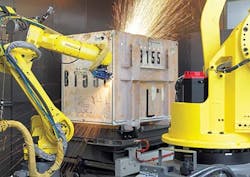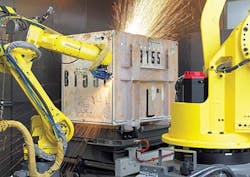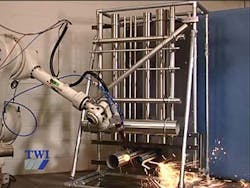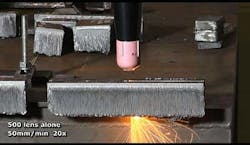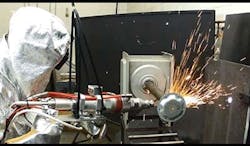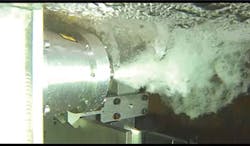Progress in the use of laser cutting for decommissioning
Process has uses in nuclear and offshore oil and gas sectors
PAUL HILTON and ALI KHAN
Since the first gas-assisted laser cuts were made at TWI in 1967, the industry has been continuously trying, one way or another, to optimize achievable cut quality. As we know, this depends on a lot of factors, but one very important parameter is the nozzle-tip-to-plate-surface distance (stand-off distance), which has to be kept small and constant as the cutting head moves. To help maintain this tight tolerance to stand-off distance, sophisticated height sense systems for control of the nozzle tip have been developed. Think now what might be possible with laser cutting if this requirement for cut quality and the requirement for a small and constant stand-off distance is removed. One application area that does not require a very high cut quality is in the field of nuclear decommissioning. This article will describe progress made since 2010 in the use of laser cutting for decommissioning, which is when TWI started to work in this area.
Decommissioning applications
There are several potential uses of laser cutting in aspects of decommissioning—these particularly involve applications in the nuclear and offshore oil and gas sectors. One thing that both these applications have in common is that the resulting cut quality is not a particular issue. The main criterion in decommissioning is that the parts being cut must separate. In the nuclear sector, applications involve reactor pressure vessels, their contents, and their associated pipework and support structures.
A second set of nuclear applications involves the decommissioning of fuel reprocessing plants and includes the cutting of pipework and containers, usually made from stainless steel, that form part of the chemistry of fuel reprocessing. The nuclear industry is very conservative in its approach to decommissioning and the techniques currently in use mainly encompass abrasive water jet cutting, diamond wire sawing, and mechanical shearing. Because of the fact that many radioactive materials are stored underwater, there is also a requirement to cut ("size reduce" in nuclear parlance) underwater. For the latter applications, a main driver for this is simply to reduce the volume of material (such as empty fuel storage containers), which is currently taking up (expensive) space in the many "ponds" on nuclear site-licensed installations (FIGURE).
Almost every year, the US, the UK, and France re-estimate the costs (to the taxpayer) of decommissioning their nuclear liabilities. The costs arrived at are so large and difficult to comprehend that it almost makes no sense to write them down as figures. What is clear, though, is that the bodies responsible for decommissioning now want to do it cheaper and faster, but safely. The latter is still the most important. Reliable and compact 1µm laser sources and their capability to deliver large power levels down optical fibers makes laser cutting for decommissioning a real possibility, mainly because the expensive part of the equipment can be located well away from the radioactive areas and therefore could be reused when one job is completed.
How laser cutting can help
Back in 2010, one of the first things TWI was asked was "can you cut stainless steel tube from just one side?" Originally, we were skeptical, but single-sided tube cutting is, in fact, a good example of what laser cutting can achieve. If the requirement for a quality edge finish is removed, then the tolerance to stand-off distance becomes much larger. TWI has cut stainless steel tube (from one side only), 170mm in diameter and with 8mm wall thickness, using only a 5kW laser source and a specially developed cutting head. A demonstration of single-sided tube cutting can be seen in VIDEO 1 (see http://bcove.me/njk7cy53), which shows an array of tubes of various sizes (including concentric tubes) being cut using only compressed air assist gas, with the aid of an articulated arm robot. The video has been sped up, but to cut the whole array shown took only 15 minutes.
More recently, work has focused on cutting thick (40 and 100mm) C-Mn steel bar and plate material, with parameters that maintained a large tolerance to the position of the cutting head. This work was in relation to applications in which the processing must be done completely remotely and where the exact position/size of the component is unknown. VIDEO 2 (see http://bcove.me/otnpdn52) shows the cutting of 40mm-thick C-Mn steel plate, again using 5kW of power, but the cutting head is being twice-cycled up and down, through a distance of 100mm, along the length of the cut, while all remaining parameters remain constant. Again, this video is speeded up and the actual horizontal speed of the nozzle tip is 50mm/min. What is clear is the huge tolerance available in stand-off distance. Using 10kW of power, it has been possible to cut over 100mm of C-Mn steel plate at 20mm/min.
At various discussions with the UK nuclear community, we were also asked if it would be possible to cut with a handheld laser "gun." We initially laughed at this suggestion, but went on to demonstrate that you can take a laser cutting head, add a pistol grip, provide suitable PPE, and (following an extensive risk assessment) do just that. VIDEO 3 (see http://bcove.me/6xdr78o3) shows this in action in one of TWI's processing cells: At the end of the clip, one of the benefits of decommissioning in this way can be seen and that is its capability to achieve a high packing density of the resulting parts. This is important because volume equates to cost when storing radioactive waste material.
The ability to cut underwater, mentioned previously, would also be of benefit in decommissioning. This, too, has now been demonstrated, although the specially designed cutting head in fact uses additional steams of compressed air to establish a local dry zone at the point where the laser beam interacts with the surface being cut. This work can be seen in VIDEO 4 (see http://bcove.me/8hdit08u), where the head has been used to cut 12- and 35mm-thick stainless steel plate, underwater, using a 5kW laser source. In this video, the cutting is in real time. What is interesting is that notwithstanding the heat sink effect of the water on the material being cut, speeds approaching those possible when cutting conventionally "in air" can still be achieved.
Potential cost savings
It was mentioned earlier that size and cost are heavily linked when it comes to storing nuclear waste. In the UK, there are a very large number of radioactive metal storage skips, which have been used over many years for storing and moving fuel elements for the Magnox reactors. The cost of storing low- and intermediate-level nuclear waste is related to the volume of the parts—in this case, about 1 m3 per skip. The estimated cost (to the UK taxpayer) of storing one such skip, for its lifetime, is £500,000. There are probably about 3000 of these skips in the UK.
Magnox has investigated a decommissioning approach for these skips, which will result in a significant reduction in the amount of active material that has to be stored because almost all of the activity in these skips is restricted to within 1.5mm of the material surface. The approach is to use laser cutting to divide the skip (which has a complex geometry on two of its sides) into five pieces. Each piece will then be passed into a five-axis milling machine, where its geometry will be scanned and a program developed to cut about 1.5mm off each exposed surface. Once the cutting dross and the milling swarf are recuperated, this active material will form a mass of just over 50kg, compared to the 450kg weight of an empty skip. It will also have a high packing density, so the volume remaining in storage will be significantly reduced. Another "green" benefit is that the remaining (non-active) material can be melted and recycled. Despite the relatively high capital investment in a laser cutting system and a multi-axis milling machine, the potential cost saving for just 300 skips is estimated at £30 million. TWI has been involved in developing cutting parameters and robot programming for this process.
In early 2014, the process was demonstrated at TWI, to Magnox personnel and other invited people from the nuclear sector, where a mockup of the laser cutting cell and robotic part manipulators had been assembled. Because of the success of this demonstration, the equipment was subsequently moved to a site-licensed company in the UK for the first trials on active skips, which took place in December 2014. VIDEO 5 (see http://bcove.me/i7v4oxni) shows the cutting of one such skip at TWI during the demonstration. It can be seen that where the cutting of the two plain, narrow sides of the skip is very simple, the strengthening material, in the form of U-shaped channels welded to the two long sides, makes cutting these sides much more difficult, but still possible with a 5kW laser.
Outlook
Our first work on laser cutting waste skips was conducted in 2011, but to demonstrate cutting using radioactive material has taken over three years. The reason for this time scale is because so much work has had to go into establishing the "safety case" for the use of laser cutting in a nuclear environment. This is what we would call a risk assessment, but is about 1000 times more severe. As well as conducting the trials mentioned above, TWI has also been working on aspects of this safety case. This involves, for example, measurement and quantification of the dross and fume generated and the effects of "stray" laser beams passing through the cut on other items in the vicinity of the process. Nevertheless, three years to move from concept to active demonstration might seem long in our terms, but for the nuclear industry in the UK, this is light speed!
PAUL HILTON([email protected]) and ALI KHAN are with TWI, Great Abington, Cambridgeshire, England; www.twi-global.com.
